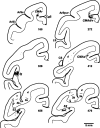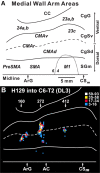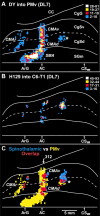The spinothalamic system targets motor and sensory areas in the cerebral cortex of monkeys
- PMID: 19906970
- PMCID: PMC2796243
- DOI: 10.1523/JNEUROSCI.3398-09.2009
The spinothalamic system targets motor and sensory areas in the cerebral cortex of monkeys
Abstract
Classically, the spinothalamic (ST) system has been viewed as the major pathway for transmitting nociceptive and thermoceptive information to the cerebral cortex. There is a long-standing controversy about the cortical targets of this system. We used anterograde transneuronal transport of the H129 strain of herpes simplex virus type 1 in the Cebus monkey to label the cortical areas that receive ST input. We found that the ST system reaches multiple cortical areas located in the contralateral hemisphere. The major targets are granular insular cortex, secondary somatosensory cortex and several cortical areas in the cingulate sulcus. It is noteworthy that comparable cortical regions in humans consistently display activation when subjects are acutely exposed to painful stimuli. We next combined anterograde transneuronal transport of virus with injections of a conventional tracer into the ventral premotor area (PMv). We used the PMv injection to identify the cingulate motor areas on the medial wall of the hemisphere. This combined approach demonstrated that each of the cingulate motor areas receives ST input. Our meta-analysis of imaging studies indicates that the human equivalents of the three cingulate motor areas also correspond to sites of pain-related activation. The cingulate motor areas in the monkey project directly to the primary motor cortex and to the spinal cord. Thus, the substrate exists for the ST system to have an important influence on the cortical control of movement.
Figures












Similar articles
-
The origin of corticospinal projections from the premotor areas in the frontal lobe.J Neurosci. 1991 Mar;11(3):667-89. doi: 10.1523/JNEUROSCI.11-03-00667.1991. J Neurosci. 1991. PMID: 1705965 Free PMC article.
-
Topographic organization of corticospinal projections from the frontal lobe: motor areas on the medial surface of the hemisphere.J Neurosci. 1995 May;15(5 Pt 1):3284-306. doi: 10.1523/JNEUROSCI.15-05-03284.1995. J Neurosci. 1995. PMID: 7538558 Free PMC article.
-
A comparative fMRI study of cortical representations for thermal painful, vibrotactile, and motor performance tasks.Neuroimage. 1999 Oct;10(4):460-82. doi: 10.1006/nimg.1999.0482. Neuroimage. 1999. PMID: 10493903
-
Contributions of anterior cingulate cortex to behaviour.Brain. 1995 Feb;118 ( Pt 1):279-306. doi: 10.1093/brain/118.1.279. Brain. 1995. PMID: 7895011 Review.
-
Insights gained into pain processing from patients with focal brain lesions.Neurosci Lett. 2012 Jun 29;520(2):188-91. doi: 10.1016/j.neulet.2012.05.007. Epub 2012 May 10. Neurosci Lett. 2012. PMID: 22579692 Review.
Cited by
-
A Multisensory fMRI Investigation of Nociceptive-Preferential Cortical Regions and Responses.Front Neurosci. 2021 Apr 14;15:635733. doi: 10.3389/fnins.2021.635733. eCollection 2021. Front Neurosci. 2021. PMID: 33935632 Free PMC article.
-
Acute stress contributes to individual differences in pain and pain-related brain activity in healthy and chronic pain patients.J Neurosci. 2013 Apr 17;33(16):6826-33. doi: 10.1523/JNEUROSCI.4584-12.2013. J Neurosci. 2013. PMID: 23595741 Free PMC article.
-
Dynamic local metrics changes in patients with toothache: A resting-state functional magnetic resonance imaging study.Front Neurol. 2022 Dec 12;13:1077432. doi: 10.3389/fneur.2022.1077432. eCollection 2022. Front Neurol. 2022. PMID: 36578304 Free PMC article.
-
Optogenetic Inhibition of Glutamatergic Neurons in the Dysgranular Posterior Insular Cortex Modulates Trigeminal Neuropathic Pain in CCI-ION Rat.Neuromolecular Med. 2023 Dec;25(4):516-532. doi: 10.1007/s12017-023-08752-3. Epub 2023 Sep 12. Neuromolecular Med. 2023. PMID: 37700212
-
Weak but Critical Links between Primary Somatosensory Centers and Motor Cortex during Movement.Front Hum Neurosci. 2018 Jan 17;12:1. doi: 10.3389/fnhum.2018.00001. eCollection 2018. Front Hum Neurosci. 2018. PMID: 29387003 Free PMC article.
References
-
- Adler LJ, Gyulai FE, Diehl DJ, Mintun MA, Winter PM, Firestone LL. Regional brain activity changes associated with fentanyl analgesia elucidated by positron emission tomography. Anesth Analg. 1997;84:120–126. - PubMed
-
- Akkal D, Bioulac B, Audin J, Burbaud P. Comparison of neuronal activity in the rostral supplementary and cingulate motor areas during a task with cognitive and motor demands. Eur J Neurosci. 2002;15:887–904. - PubMed
-
- Al-Chaer ED, Feng Y, Willis WD. A role for the dorsal column in nociceptive visceral input into the thalamus of primates. J Neurophysiol. 1998;79:3143–3150. - PubMed
-
- Al-Chaer ED, Feng Y, Willis WD. Comparative study of viscerosomatic input onto postsynaptic dorsal column and spinothalamic tract neurons in the primate. J Neurophysiol. 1999;82:1876–1882. - PubMed
Publication types
MeSH terms
Substances
Grants and funding
LinkOut - more resources
Full Text Sources
Other Literature Sources
